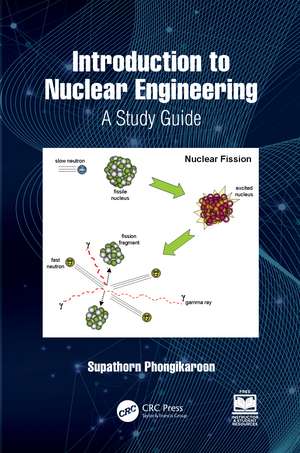Introduction to Nuclear Engineering: A Study Guide
Autor Supathorn Phongikaroonen Limba Engleză Hardback – 29 sep 2023
The book begins with basic modern physics with atomic and nuclear models. It goes on to cover nuclear energetics, radioactivity and decays, and binary nuclear reactions and basic fusion. Exploring basic radiation interactions with matter, the book finishes by discussing nuclear reactor physics, nuclear fuel cycles, and radiation doses and hazard assessment. Each chapter highlights basic concepts, examples, problems with answers, and a final assessment.
The book is intended for first-year undergraduate and graduate engineering students taking Nuclear Engineering and Nuclear Energy courses.
Preț: 649.52 lei
Preț vechi: 713.76 lei
-9% Nou
Puncte Express: 974
Preț estimativ în valută:
124.30€ • 128.41$ • 103.45£
124.30€ • 128.41$ • 103.45£
Carte disponibilă
Livrare economică 04-18 martie
Livrare express 15-21 februarie pentru 40.30 lei
Preluare comenzi: 021 569.72.76
Specificații
ISBN-13: 9781032224404
ISBN-10: 1032224401
Pagini: 306
Ilustrații: 55 Tables, black and white; 86 Line drawings, black and white; 18 Halftones, black and white; 104 Illustrations, black and white
Dimensiuni: 156 x 234 x 24 mm
Greutate: 0.73 kg
Ediția:1
Editura: CRC Press
Colecția CRC Press
ISBN-10: 1032224401
Pagini: 306
Ilustrații: 55 Tables, black and white; 86 Line drawings, black and white; 18 Halftones, black and white; 104 Illustrations, black and white
Dimensiuni: 156 x 234 x 24 mm
Greutate: 0.73 kg
Ediția:1
Editura: CRC Press
Colecția CRC Press
Public țintă
Postgraduate and Undergraduate AdvancedCuprins
1. Basic Units and the Atom. 2. Basic Modern Physics. 3. Atomic and Nuclear Models including Chart of Nuclides. 4. Nuclear Energetics I—Binding Energy and Separation Energy. 5. Nuclear Energetics II—Nuclear Reactions and Q-values. 6. Radioactivity and Radioactive Decay. 7. Binary Nuclear Reactions. 8. Radiation Interactions with Matter. 9. Neutrol Chain Reactions and Basic Nuclear Reactor Physics. 10. Nuclear Reactors, Power, and Fuel Cycles. 11. Radiation Doses and Hazards. Appendix I. Appendix II.
Notă biografică
Dr. Supathorn Phongikaroon is an Engineering Foundation Professor and Nuclear Engineering Program Director in the Department of Mechanical and Nuclear Engineering at Virginia Commonwealth University (VCU). He earned his PhD and BS degrees in chemical engineering and nuclear engineering from the University of Maryland, College Park in 2001 and 1997, respectively. Prior to joining the VCU in January 2014, he held academic and research positions at the University of Idaho in Idaho Falls, ID; Idaho National Laboratory in Idaho Falls, ID; and Naval Research Laboratory, Washington, DC. During his research career, Dr. Phongikaroon established chemical and electrochemical separation of used nuclear fuel through pyroprocessing technology and extended his expertise toward reactor physics and material detection and accountability for safeguarding applications. His effort led to a strong establishment of Radiochemistry and Laser Spectroscopy Laboratories at VCU.
His work has been published in over 50 papers in peer-reviewed journals and presented at over 100 international and national conferences and workshops. He has been able to maintain continuous diverse research support from international and national programs through the Department of Energy, national laboratories, and other universities. He has been Principal Investigator and Co-Principal Investigator for more than 20 external supported projects in total of over 3.17 million dollars of external awards since joining academia in 2007. He has taught more than 30 classes in nuclear, mechanical and chemical engineering-related topics for resident students and more than 10 classes for continuing (long distance ・video conference) education over the last 9 years.
His work has been published in over 50 papers in peer-reviewed journals and presented at over 100 international and national conferences and workshops. He has been able to maintain continuous diverse research support from international and national programs through the Department of Energy, national laboratories, and other universities. He has been Principal Investigator and Co-Principal Investigator for more than 20 external supported projects in total of over 3.17 million dollars of external awards since joining academia in 2007. He has taught more than 30 classes in nuclear, mechanical and chemical engineering-related topics for resident students and more than 10 classes for continuing (long distance ・video conference) education over the last 9 years.
Descriere
Introduction to Nuclear Engineering serves as an accompanying study guide for introductory, single-semester course in nuclear engineering. It is structured for general class use, alongside fundamental nuclear physics and engineering textbooks, and it is equally suited for individual self-study.
